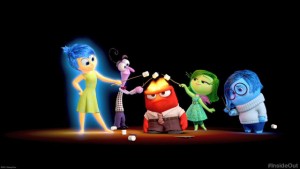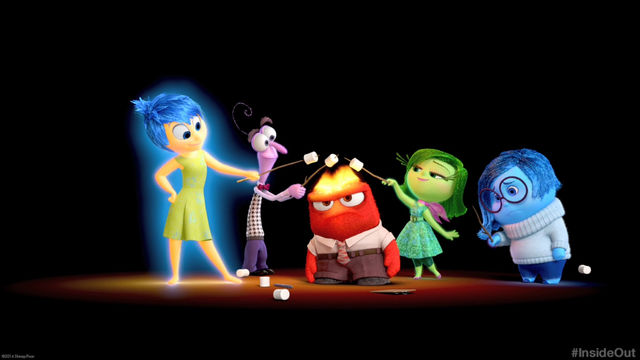Pixar has done it again. This summer’s film “Inside Out,” takes on an almost insurmountable challenge, namely to envision what’s going on in an 11 year old kid’s mind. This remarkable movie fulfills its goal in a mesmerizing, fun-filled and a truly insightful manner by giving faces and identities to almost everyone’s array of emotions: joy, fear, anger, disgust and sadness. Before the film concludes, everyone in the audience realizes, of course, that this wide array of feelings is common to people of all ages, and perhaps even to dogs and cats!

Pixar’s artistry is understood best not only by their astonishing animation and spot-on story telling, but also by their ability to distill their subject matter for people of all ages. This has been true of every one of their films, beginning with Toy Story, and continuing with “WALL-E,” “Up!,” and now “Inside Out.” We could debate whether “Inside Out” is more for children or adults, but it doesn’t matter. There is plenty in this film for every audience. After all, the same feelings that compete for dominance in a child’s mind are essentially the same feelings that converge throughout our lives. The little girl, Riley, on the edge of her adolescence struggles with what, for her, is an immensely difficult experience: moving away from her friends, her school, her house and her activities in Minnesota, across country to San Francisco. The range of emotions that well up in her is the same as those that we all struggle through, particularly in our most challenging times. As has been said many times, these feelings are not right or wrong, they just are.
Long ago, the ancient rabbis conceived of the human mind as composed primarily of two contrasting feelings or inclinations. They are the “yetzer ha-tov” and the “yetzer ha-ra,” the inclination for the good, and the inclination for the evil. These two countervailing forces vie for dominance in the human mind. It might seem logical that the rabbis say that the yetzer ha-tov must prevail. Somewhat surprisingly they taught that both inclinations are to be embraced. By this they meant that although the good inclination is generally thought of as being the most positive since it is the source of altruism, compassion, love and kindness, the other side of our inner selves also has value because it is the motivation for self-serving and self-preserving actions, e.g. competition, sexuality and other human appetites. Students of psychology will recognize in these two inclinations what later has been identified as the id and the super ego.
It seems to me that the rabbis of old were only telling part of the story. Still, they deserve great credit for being far ahead of their times. The human mind has so many more competing feelings, as “Inside Out” poignantly illustrates. Happiness, anger, anxiety, sorrow and repulsion are ever-present to some degree, as are many others, including affection, mourning, determination, and more. I think that where the ancient sages may have fallen short was in their reluctance to deal with the confusing array of emotions that flood the human mind, often unpredictably, irrationally, and simultaneously.
The rabbis certainly were aware of how powerful our feeling are. In a well-known passage in the Pirkei Avot (The Sayings of the Sages), Rabbi Simeon ben Zoma said: “Who is strong? The one who conquers his evil inclination, as it is said: ‘Better is one slow to anger than a strong man, and one who rules over his spirit than a conqueror of a city’ (Proverbs 16:32) Actually, the Hebrew word for strong is the same as the word for hero. Ben Zoma acknowledged that it takes a very strong person not to give in to the darker inclinations that we all have. He was right. It takes strength, even courage, to transcend the feelings that are deeply rooted in us, some intrinsically and others by our life experiences. This is the challenge that each of us faces continuously. It is important to recognize that Ben Zoma does not suggest that we can erase these feelings, only that we must do our best not to allow them to dominate.
Our most intense feelings, most often, are the consequence of our experiences, the residue of which remain long after these events have occurred. Our most painful experiences are the ones that really mold us, and impact on our daily lives because, unfortunately, our bitter experiences are the most vivid, and they have a very long after-life.
Taking “Inside Out’s” not-so-fictitious Riley as an example, can there be any doubt that her unwanted experience of moving away to a new and scary place would shape her for years to come? Any of us who have gone through the ordeal of an involuntary relocation know that those feelings haunt us. They definitely impact our attitude toward other unexpected events in our lives.
As this film illustrates so vividly, the complicated amalgam of our feelings, rooted in past experiences, impacts how we deal with real-time events in our lives.
I am writing this essay in the aftermath of the horrendous attack at the church in Charleston, which was the direct consequence of racial hatred. So I am thinking especially these days of the curse of racism. Is there any emotion that could be more hurtful than that of baseless hatred of those whose color is different than our own? The irrational hatred of the other continues to prevent our nation from fulfilling the Constitution’s vision of equal rights for all.
When I saw anger portrayed in Riley’s mind as a man with his head on fire, growling every single phrase (thanks to Lewis Black), I thought to myself: This is what racism looks like, except that, unlike in the movie, there is nothing humorous about it.
Every one of us harbors negative attitudes, most of which are irrational. It does no good to deny their existence. But, as Ben Zoma put it, we can conquer them. There is a world of difference between having the feelings and letting them govern our behavior. That’s the point.
Many years ago, President Jimmy Carter made the confession, to having “lusted in his heart.” He regarded that as a sin. From the perspective of Ben Zoma, my response was: So what? As long as no action followed when he set his eyes upon a desirable woman, no sin was committed. Perhaps the one who has such inclinations but refuses to act on impulse is more to be admired than one who never felt tempted.
And I would add to this: one who is aware of his/her prejudices, whether they be racial, religious or of any other kind, but transcends these feelings, is truly strong.
I would say that this is the great challenge facing our nation; for our people to admit sadly that racism is deeply rooted in our psyche, most of it passed down over many generations. However this does not mean than such negative attitudes need to be acted upon or passed down to the next generation. In “The King and I,” the King of Siam sings of prejudice, “You’ve got to be taught.” The curse of racism will be removed when parents, by word and especially by deed, acknowledge the existence of these destructive irrational feelings and resolve not to pass them down. That is a tall order, to be sure, but it is a challenge that must be faced squarely if we are ever to remove the blot of America’s original sin.
Let me conclude with a word especially for parents. It does no good for parent to say to their children, “You shouldn’t feel that way.” We adults cannot control our own emotions. They just happen. The same is true for children. Better we should say, “Okay, these are your feelings. Now what are you going to do about them?” It is far more constructive to acknowledge the power of emotions in children’s (and our own) minds than to suggest that these feelings ought to just go away. For better or for worse, they reside within us always.
I will conclude with Ben Zoma: Who is strong? The one who admits that he/she harbors strong negative feelings but resolves: “In spite of these feelings I will not allow them to direct my behavior.”
Tags: articles, inside out